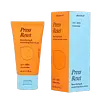What's inside
What's inside
 Key Ingredients
Key Ingredients

 Benefits
Benefits

 Concerns
Concerns

 Ingredients Side-by-side
Ingredients Side-by-side

Water
Skin ConditioningDipotassium Azelate
Glycolic Acid
BufferingC12-13 Alkyl Lactate
EmollientMagnesium Aluminum Silicate
AbsorbentSuccinic Acid
BufferingAcrylamide/Sodium Acryloyldimethyltaurate Copolymer
Emulsion StabilisingXanthan Gum
EmulsifyingDimethyl Isosorbide
SolventMagnesium/Aluminum/Hydroxide/Carbonate
Azelaic Acid
BufferingTocopheryl Acetate
AntioxidantC13-14 Isoparaffin
EmollientHydroxypinacolone Retinoate
Skin ConditioningLaureth-7
EmulsifyingTrisodium Ethylenediamine Disuccinate
Water, Dipotassium Azelate, Glycolic Acid, C12-13 Alkyl Lactate, Magnesium Aluminum Silicate, Succinic Acid, Acrylamide/Sodium Acryloyldimethyltaurate Copolymer, Xanthan Gum, Dimethyl Isosorbide, Magnesium/Aluminum/Hydroxide/Carbonate, Azelaic Acid, Tocopheryl Acetate, C13-14 Isoparaffin, Hydroxypinacolone Retinoate, Laureth-7, Trisodium Ethylenediamine Disuccinate
Water
Skin ConditioningDicaprylyl Ether
EmollientAzelaic Acid
BufferingPropanediol
SolventGlycolic Acid
BufferingGlycerin
HumectantCoco-Caprylate/Caprate
EmollientCetearyl Alcohol
EmollientCeteareth-20
CleansingGlyceryl Stearate
EmollientPEG-100 Stearate
Dioscorea Villosa Root Extract
Skin ConditioningGlycyrrhiza Glabra Root Extract
BleachingPyridoxine Hcl
Skin ConditioningZinc PCA
HumectantNiacinamide
SmoothingSoy Isoflavones
Skin ConditioningLecithin
EmollientPhytosterols
Skin ConditioningCeramide NP
Skin ConditioningSqualane
EmollientButyrospermum Parkii Butter
Skin ConditioningCaprylic/Capric Triglyceride
MaskingHydroxyethyl Acrylate/Sodium Acryloyldimethyl Taurate Copolymer
Emulsion StabilisingPolysorbate 60
EmulsifyingSorbitan Isostearate
EmulsifyingSalicylic Acid
MaskingSodium Polyacryloyldimethyl Taurate
Emulsion StabilisingSilica
AbrasivePhenoxyethanol
Preservative1,2-Hexanediol
Skin ConditioningDimethicone
EmollientTocopheryl Acetate
AntioxidantDisodium EDTA
Sodium Hydroxide
BufferingWater, Dicaprylyl Ether, Azelaic Acid, Propanediol, Glycolic Acid, Glycerin, Coco-Caprylate/Caprate, Cetearyl Alcohol, Ceteareth-20, Glyceryl Stearate, PEG-100 Stearate, Dioscorea Villosa Root Extract, Glycyrrhiza Glabra Root Extract, Pyridoxine Hcl, Zinc PCA, Niacinamide, Soy Isoflavones, Lecithin, Phytosterols, Ceramide NP, Squalane, Butyrospermum Parkii Butter, Caprylic/Capric Triglyceride, Hydroxyethyl Acrylate/Sodium Acryloyldimethyl Taurate Copolymer, Polysorbate 60, Sorbitan Isostearate, Salicylic Acid, Sodium Polyacryloyldimethyl Taurate, Silica, Phenoxyethanol, 1,2-Hexanediol, Dimethicone, Tocopheryl Acetate, Disodium EDTA, Sodium Hydroxide
Ingredients Explained
These ingredients are found in both products.
Ingredients higher up in an ingredient list are typically present in a larger amount.
Azelaic acid is a multitasker ingredient that helps treat acne, pigmentation, and irritation. It is a great option for sensitive skin.
What makes azelaic special?
The best thing about azelaic acid is it's gentleness. It's generally well-tolerated and safe to use alongside other actives like niacinamide or salicylic acid.
Unlike AHAs, azelaic acid will not make you photosensitive/sun sensitive.
You can find this ingredient naturally occurring in grains like wheat, rye, and barley. In cosmetics, azelaic acid is typically lab-made, which is more stable and effective.
Learn more about Azelaic AcidGlycolic Acid is arguably the most famous alpha hydroxy acid (AHA) with tons of research backing its benefits.
It is found naturally in sugar cane but the form used in skincare is usually synthetic for purity and stability.
Glycolic acid removes the top layer of dead skin cells to allow newer and fresher ones to emerge.
AHAs work by breaking down the structural “glue” that holds old skin cells in place. When that buildup is gone, your skin can renew itself more efficiently.
Research also shows glycolic acid stimulates collagen production, helping to firm and thicken the skin over time. This is one of its biggest advantages over other AHAs.
Overall, glycolic acid helps with:
Fun fact: Glycolic acid boosts skin hydration by helping it produce molecules that increase hyaluronic acid naturally.
To work best, glycolic acid products should have a pH between 3-4 (that’s where exfoliation is most effective but still gentle on skin).
The pH and concentration of a product are key to its effectiveness:
It is normal to feel a slight stinging sensation when using glycolic acid. This usually fades as your skin adjusts.
Because glycolic acid has the smallest molecular size in the AHA family, it can penetrate deeper, which enhances its effectiveness but also makes it more likely to irritate sensitive skin.
If your skin is very sensitive or prone to rosacea, glycolic acid may be too strong; in that case, try milder options like lactic acid or a PHA instead.
Recent studies suggest glycolic acid might even help protect against UV damage. But don’t skip sunscreen! Freshly exfoliated skin is more sensitive to the sun.
Glycolic acid is a skincare superstar. It smooths, brightens, hydrates, and firms the skin. Unless you’re highly sensitive, it’s well worth adding to your routine.
Read more about some other popular AHA's here:
Learn more about Glycolic AcidTocopheryl Acetate is AKA Vitamin E. It is an antioxidant and protects your skin from free radicals. Free radicals damage the skin by breaking down collagen.
One study found using Tocopheryl Acetate with Vitamin C decreased the number of sunburned cells.
Tocopheryl Acetate is commonly found in both skincare and dietary supplements.
Learn more about Tocopheryl AcetateWater. It's the most common cosmetic ingredient of all. You'll usually see it at the top of ingredient lists, meaning that it makes up the largest part of the product.
So why is it so popular? Water most often acts as a solvent - this means that it helps dissolve other ingredients into the formulation.
You'll also recognize water as that liquid we all need to stay alive. If you see this, drink a glass of water. Stay hydrated!
Learn more about Water